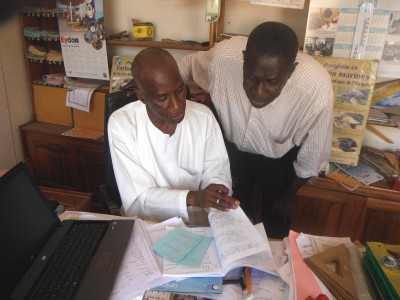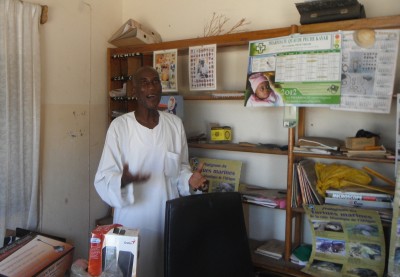The assessment of the experiences between June and July 2012 was made with the Director of the primary school Kayar 1, Mr. Ndiaye, during two missions of the project coordinator, Aliou Sall, in July 2012. Mr. Ndiaye is also one of the teachers participating actively in the pilot activities. Exchanges between the school principal and the coordinator produced the following highlights:
I. Approach and strategy chosen
There is a peculiarity of the school Kayar 1 regarding the approach to the implementation of the pilot activities.

While in other schools - both in Gambia and Senegal - only two experimental classes from each participating school are fully engaged in the exercises, the school principal of Kayar 1, working with his staff and parents, took the initiative to expand the ecosystem approach to fisheries (EAF) according to the EAF-Nansen project at all levels, namely the CI to CM2. So, the exercises (some extended until about August 4, 2012) covered all classes. Moreover, a total of five more teachers have been involved in addition to Mr Ndiaye. Each of the teaching staff has been assigned one of the five key principles. The other five teachers are Mr. Samba BA (for ecosystem integrity), Mr. Aliou FALL (improving research), Mr. Saliou SOW (precautionary approach), Mr. Samba FAYE (widening participation) and Mrs. Moussou DEMBÉLÉ (multi-sectoral approach). We note in passing that the school principal, along with one of two school teachers involved in the project, has extensive experience with the programmes (of international NGOs and public institutions) about the awareness on environmental issues.
Social mobilisation is considered by the primary school of Kayar 1 as a prerequisite for project success. Indeed, according to the director, the successful pilot phase is due to the active collaboration of social actors whenever they are requested. The mobilisation of these social actors - apart from officials and employees of the fisheries administration on site - owes its success to the approach taken by the teaching staff. They had identified three vector of people who werer not only expected to 'own' the project, but also carry its message as opinion leaders into the community. To achieve this, the teaching team relied on three groups, called the three hearings, namely: (i) those who have no idea about the concept of environment and its reality, much less focused on the EAF and marine ecosystems, (ii) those who are relatively well-informed, and finally (iii) the audience of customary chiefs and delegates from districts who have traditionally played an important role in social mediation.
II. The activities and actual achievements
a. Classroom exercises
Each class is subdivided into five working groups for the purposes of the exercises. This approach is maintained even for external observations. The exercises focused on five "key principles" in the following courses:
Drawing: A few pieces of pencil drawings called "argumentative design" has been made, with great emphasis to the key principle "Ecosystem Integrity." The message on which the pupils worked as follows: "Destroying the sea, is to commit ecological genocide".
French: During the credit hours for French, the students created poems on the five key principles, in the part of the course called "Written expression". The idea is to make a collection of poems, once that a sufficient number would be selected.
Performing arts: Several auditions are still ongoing. However, the school has already produced a sketch that was inspired by the two posters provided by the project (project EAF-Nansen poster and the poster on the Senegambian ecosystem). For the record: The Senegalese side did not have the full guideline and EAF-Nansen displays in time for the start-up workshop. But when these elements were available - in English for the Gambia - the project coordinator has taken the initiative to help the Senegalese teachers to take ownership of these basic and important elements of the teaching kit to fill the gap between the two countries. He visited all schools organising catch-up sessions during the month of April. Also, he relied on two teachers from both mid-level schools (Messrs. DIOP based in Kayar and SARR in Hann, who have a good level of English and who have continued to provide support at the request of other teachers).
The sketch was so interesting that a local community television channel called Channel 8 Kayar was filmed the performance (copy of this sketch will be negotiated with the director for reporting purposes). In addition to this sketch, the pupils have produced another whose cast covers three sequences: (i) What is the marine environment?; (ii) What is the difference between a healthy and a sick environment?; (iii) What new vision and approach towards the environment?
For lack of appropriate audio-visual media, some pupils took a few scenes with mobile phones, but these have limitations in terms of both storage capacity and mage quality. The headmaster has promised to the coordinator at the latter's last visit to the site, to recover the maximum of images of the pupils for an aggregate presentation and higher recognition for their work.
Hearing: One of the most interesting and innovative initiatives undertaken in the pilot activities was to hold a hearing within the school for which the teaching team had invited some fishermen from the community of Kayar known for their solid grasp of the main vicissitudes experienced by the marine environment in recent years. Aged around 55 to 60 years, these fishermen came to testify to the young people on the rapid degradation of ecosystems, which they have observed throughout the years. Having entered the fishery very young (from the age of12 years or even less in some families, to at most 15 years) their rich experience accumulated over time allowed them to give a comparative picture of the situation from the 1970s to our days. In addition to the degradation of marine resources in general, they commented on some emblematic species that either have become rare or disappeared completely. This kind of conference was a first opportunity given to persons of a certain age to talk to their grandchildren (pictures taken with whatever means will be collected for reporting purposes).

It was an opportunity for the awakening of a collective memory in favour of an awareness of the younger generation. Mr Ndiaye explains the context within which the school works: "While environmental education is encouraged and decided by public authorities, we do not have a precisely defined and formal programme. We have a favourable receptacle and we must create the programme based on our own initiative and according to the tools we find. The tools at our disposal through the EAF-Nansen are therefore timely and represent an important added value for us. Currently, as a pilot school are also benefiting from a pilot project implemented by the Republic of Korea (Sankore Project). I have no problem since I can progressively integrate the tools provided by the NANSEN project into the software provided by the project."
On the methodological approach to the exercises, this is the process used by the school principal:
-
External observations by students after preparation by the teachers, this phase of the first immersion is the opportunity for the young pupils to ask questions and begin to make assumptions;
-
Back in class the teacher helps to formulate the pupil's thoughts, because they still have their limits;
-
Thereafter follows the classification phase through which the teacher helps the pupils organize and analyse their thoughts.
-
This amounts in other words to the following process: make an experience, classification of ideas, theory formation, synthesis and evaluation, which should result in proposed solutions. So, in the end - for every problem or issue posed – it's a matter of helping the pupils identify the problem, define the causes and propose solutions. According to Mr Ndiaye, this process should be visible in detail through the exercises, whether they are drawings, sketches, texts or other commentary. These are achievements of the pupils, which can attest to whether or not they have acquired complete ownership of key principles and the messages resulting from they.
b. The external observations
On exercises outside the classroom, the main strengths to remember are as follows:
Preparation Phase: Teachers prepare the ground by making the necessary contacts with those to be visited. The posters are very useful tools for preparing the observations, which are in the time slot entitled "field trip".
Tools: The tools of data collection are various: the fishruler, questionnaire surveys, interviews and recorder. In some cases, for the shooting, use the services of a paid photographer or videographer.
Profiles of those met: Management Team of the Marine Protected Area (MPA) Kayar, officers of the Departmental Fisheries Service Kayar, representatives of fishermen's association and active fishmongers, met at Pencs and shelters of old retired fishermen.
III. Constraints and prospects for an improved learning environment

With all the opportunities provided by the introduction of the EAF in the curriculum, the team of Kayar 1 identified a number of constraints of different nature, which delayed the implementation of the pilot phase, as it would have wished, namely:
Administrative and socio-political conditions: Senegal has just emerged from a paralysis of the school system, which lasted almost seven months. There will thus be no school holidays for pupils and teachers of the secondary cycle. This crisis has not spared the primary cycle. The planned exercises have been limited, given the fact that to save the year, schools had to offer remedial courses for pupils. which does not give enough time to run the whole schedule of the first phase.
Logistics: The initiative of the Senegalese-Korean cooperation will enable a more efficient use of tools and media (audio, writings made available by the project EAF-NANSEN). However, teachers remain convinced that they must work - even approaching the Korean cooperation and other cooperation actors - to equip themselves with good digital camera, in the absence of a video camera to document the exercises all the time. The teachers regretted not to have a camera at their disposal so far. They have also raised the need to develop a corner of their library with documentation (including virtual media) devoted to the theme of marine ecosystems and on-going initiatives to restore them, such the EAF-NANSEN pilots.
In addition, anxious to ensure benefits for the pupils and especially in order to show them they did useful work, the teachers agreed to leverage the work of these young people. They conduct the following activities: (i) collecting best argumentative drawings made during the year and organise an inter-class competition. The selected designs will be collected in a document as a basis for the library; (ii) Collection of best poems for the library; (iii) Gradual establishment of a gallery to be fueled by the photos taken during exercises. The aim is to gradually build a database and supports, which could be a traveling exhibition through other schools. They could also be exposed during major events, such as World Oceans Day on 8 June each year.








